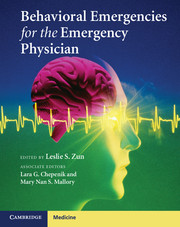Book contents
- Behavioral Emergencies for the Emergency Physician
- Behavioral Emergencies for the Emergency Physician
- Copyright page
- Contents
- Contributors
- Preface
- Section 1. General considerations for psychiatric care in the emergency department
- Chapter 1 The magnitude of the problem of psychiatric illness presenting in the emergency department
- Chapter 2 Delivery models of emergency psychiatric care
- Section 2. Evaluation of the psychiatric patient
- Section 3. Psychiatric illnesses
- Section 4. Treatment of the psychiatric patient
- Section 5. Special populations
- Section 6. Administration of psychiatric care
- Index
Chapter 2 - Delivery models of emergency psychiatric care
from Section 1. - General considerations for psychiatric care in the emergency department
Published online by Cambridge University Press: 05 April 2013
- Behavioral Emergencies for the Emergency Physician
- Behavioral Emergencies for the Emergency Physician
- Copyright page
- Contents
- Contributors
- Preface
- Section 1. General considerations for psychiatric care in the emergency department
- Chapter 1 The magnitude of the problem of psychiatric illness presenting in the emergency department
- Chapter 2 Delivery models of emergency psychiatric care
- Section 2. Evaluation of the psychiatric patient
- Section 3. Psychiatric illnesses
- Section 4. Treatment of the psychiatric patient
- Section 5. Special populations
- Section 6. Administration of psychiatric care
- Index
Summary
- Type
- Chapter
- Information
- Behavioral Emergencies for the Emergency Physician , pp. 11 - 18Publisher: Cambridge University PressPrint publication year: 2013
- 2
- Cited by



